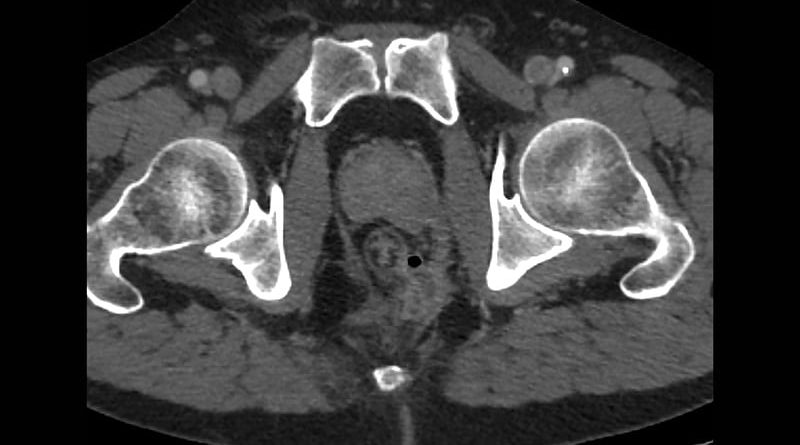CT Reliably Detects Internal Herniation After Gastric Bypass
Abdominal CT reliably detects internal herniation in patients with abdominal pain after Roux-en-Y gastric bypass surgery and can help providers select appropriate patients for exploratory surgery, according to a systematic review and meta-analysis.

Dr Carlyle Dunshee
“This study shows that a CT scan of the abdomen is a reliable diagnostic tool, especially if signs such as venous congestion or mesenteric edema are noted,” Carlyle M. Dunshee, MD, FACS, FASMBS, DABOM, an assistant professor of surgery and the chief of the Division of Metabolic, Bariatric, and Minimally Invasive Surgery at the University of Kansas Medical Center in Kansas City, Kansas, told Medscape Medical News in an email.
“Internal hernia following Roux-en-Y gastric bypass (RYGB) is an important complication affecting up to 5% of patients following surgery,” added Dunshee, who was not involved in the study. “Diagnosis requires a high index of suspicion. Missing the diagnosis can result in significant morbidity or even mortality. Exploratory laparoscopy or laparotomy may be required to make the diagnosis.”
Exploratory surgery is the gold standard in diagnosing internal herniation, the authors write in an article published in Annals of Surgery. Although CT scans are often used to help diagnose internal herniation, their diagnostic accuracy has been unclear.
Lead author May Al Nawas, MD, and colleagues in the Departments of Surgery and Radiology of St. Antonius Hospital in Nieuwegein, the Netherlands, analyzed the accuracy of abdominal CT in diagnosing internal herniation following RYGB surgery.
They searched medical databases for relevant articles in English that described the accuracy of abdominal CT in diagnosing internal herniation in adult patients who had previously undergone RYGB surgery for morbid obesity. They excluded reviews, case reports, and case series and included only studies that compared the diagnostic accuracy of CT with the outcome of exploratory surgery or the combination of CT and a negative follow-up assessment 90 days after CT.
Twenty studies met their inclusion criteria. The studies were published between 2007 and 2020 and included a total of 1637 patients. One study was prospective, and most were retrospective. The researchers extracted, recalculated, and pooled data to present the overall accuracy of CT in diagnosing internal herniation and the diagnostic accuracy of specific radiologic signs.
-
From the 17 studies that provided data on overall diagnostic accuracy, the authors calculated pooled sensitivity (82.0%), specificity (84.8%), positive predictive value (82.7%), and negative predictive value (85.8%).
-
From the 11 studies that reported specific CT signs and their diagnostic accuracy, the signs with the highest sensitivities were venous congestion (78.7%), swirl (77.8%), and mesenteric edema (67.2%).
Bestoun H. Ahmed, MD, FACS, FRCS, an associate professor of surgery in the Division of Minimally Invasive Bariatric and General Surgery at the University of Pittsburgh Medical Center in Pennsylvania, welcomed the findings.

Dr Bestoun Ahmed
“The study strongly supports other studies’ conclusions of obtaining CT in patients with abdominal pain following RYGB,” Ahmed, who also was not involved in the study, said in an email. “This study is unique in including a very large number of patients, which enabled important subgroup analyses.”
If not treated quickly, internal herniation following RYGB can lead to bowel gangrene, perforation, sepsis, and death, he cautioned.
“Metabolic surgeons should consider clinical and radiologic interpretations in their management plans for optimum diagnostic accuracy and for decreasing the likelihood of negative exploration or missing a real intra-abdominal pathology,” he advised. “However, the total ionizing radiation dose needs to be considered.”
Ahmed said that with only one prospective study, selection bias could be a problem.
“These findings are important, but the need remains for large-scale, prospective studies and more stringent follow-up for patients observed in the absence of alarming CT findings,” he added.
Dunshee also welcomed the study and was not surprised by its results.
“This study helps confirm the utility of the CT modality,” he said. “I have found the CT scan a useful adjunct in my practice, especially with positive findings. A negative CT scan does not eliminate the diagnosis, and, if my index of suspicion is high, exploration is still warranted.
“Hopefully this study helps primary care and other acute care physicians understand the significance and importance of internal hernia following gastric bypass,” he added.
The authors recommend further research to help physicians select appropriate patients for post-RYGB exploratory surgery.
Funding information was not provided. The authors, Dunshee, and Ahmed report no relevant financial relationships.
Ann Surg. 2022 May 1;275:856-863. Abstract
For more news, follow Medscape on Facebook, Twitter, Instagram, and YouTube.
Source: Read Full Article



